Discover the Chesapeake Bay Retriever’s rich history, unique physical and behavioral traits, expert care and training tips and why they are excellent gun dogs.
Introduction
The Chesapeake Bay Retriever, often known as the “Curly Hunter,” is a remarkable breed renowned for its resilience and versatility. Originating from the rugged coasts of the Chesapeake Bay, this breed has a storied history that blends the tenacity of its ancestors with the evolution of modern hunting dogs.
Whether you’re drawn to their hunting prowess, their loyal guarding instincts, or their distinctive physical and behavioral traits, this guide has your answers. The Chesapeake Bay Retriever offers a unique combination of qualities, that make them exceptional companions and working dogs. Let’s begin, and explore this extraordinary breed.
Chesapeake Bay Retriever Origin and History
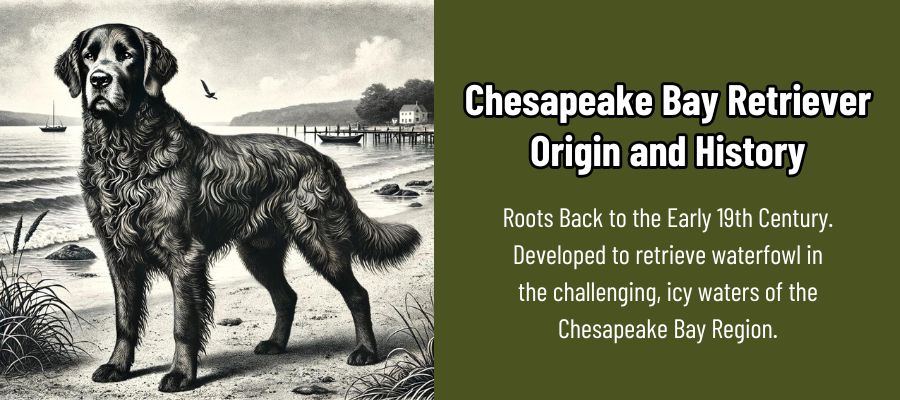
The Chesapeake Bay Retriever boasts a rich history, rooted in the Chesapeake Bay area of the United States. Known for their exceptional hunting skills and resilience, these dogs have evolved from a blend of hardy breeds to become a beloved companion for hunters and families alike.
Ancestors
The Chesapeake Bay Retriever origin date back to the early 19th century in the Chesapeake Bay region, where they were developed to retrieve waterfowl in the challenging, icy waters.
The breed’s foundation is attributed to the 1807 shipwreck survivors, two Newfoundland dogs named Sailor and Canton. These dogs were bred with local dogs, including coonhounds, setters, and possibly flat-coated retrievers, to produce a line of canines known for their endurance, intelligence, and excellent retrieving abilities.
These ancestors were selectively bred for their ability to withstand harsh conditions and perform demanding tasks, laying the groundwork for the modern Chesapeake Bay Retriever.
Evolution
Throughout the 19th and early 20th centuries, the Chesapeake Bay Retriever’s development was influenced by the demands of waterfowl hunters in the region. Significant milestones include the formal recognition of the breed in 1918 by the American Kennel Club (AKC). The breed continued to gain popularity, known for its distinctive curly coat, stamina, and versatility.
Key events in their evolution include their use by market hunters in the 19th century, who valued their ability to retrieve hundreds of ducks a day. The Chesapeake Bay Retriever’s reputation grew as a reliable and hardworking hunting dog, with successive generations honing their skills and solidifying their status.
Breed Status
Today, the Chessie Retriever is a thriving breed, cherished not only in the United States but worldwide. In the USA, there are thousands of registered Chesapeake Bay Retriever, reflecting their continued popularity among hunting enthusiasts and families.
Globally, the breed has a strong presence, particularly in countries with active hunting and outdoor communities. The Chesapeake Bay Retriever remains a versatile dog, excelling in various roles from hunting to search and rescue, showcasing their enduring appeal and adaptability.
Kennel Clubs
The Chesapeake Bay Retriever has earned recognition from several prestigious kennel clubs:
- AKC – American Kennel Club (USA): Recognized in 1918, the AKC played a crucial role in standardizing the breed and promoting its attributes.
- UKC – United Kennel Club (USA): Also recognizes the Chesapeake Bay Retriever, emphasizing its working dog capabilities.
- TKC – The Kennel Club (UK): Recognizes the breed, highlighting its versatility and popularity beyond the United States.
- CKC – Canadian Kennel Club (Canada): Recognizes the Chesapeake Bay Retriever, reflecting its popularity in Canada, especially among hunters.
In addition to these major kennel clubs, there are several specialized clubs dedicated to the breed, such as the American Chesapeake Club, which was established in 1918 and focuses on the promotion and preservation of the breed.
Chesapeake Bay Retriever In Action
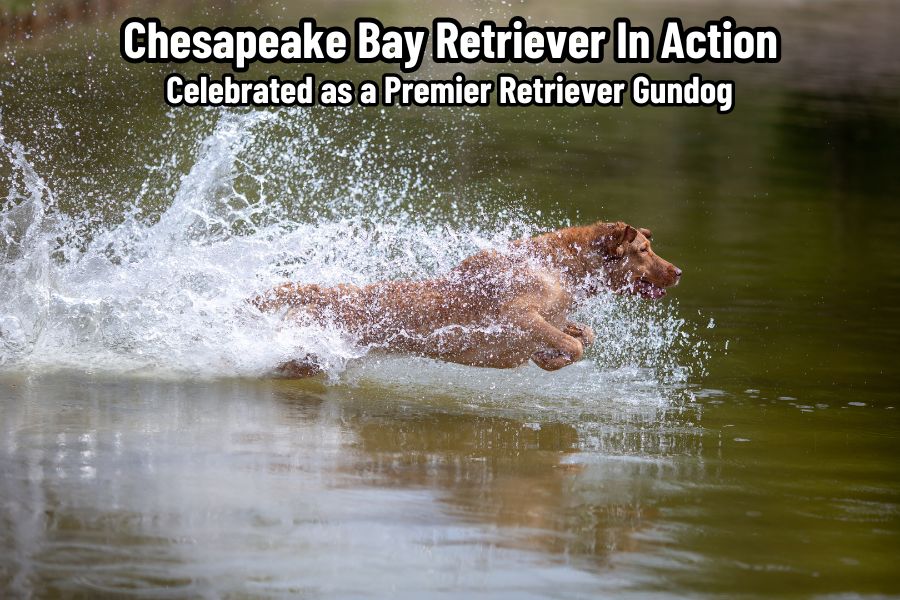
The Chesapeake Bay Retriever is renowned for its versatility and intelligence, thriving not only as an exceptional hunting dog but also excelling in various other roles. This breed’s adaptability and drive make it a remarkable companion in many fields.
Hunting Dog
The Chesapeake Bay Retriever is celebrated as a premier retriever gun dog, a role rooted in its origins and honed through generations of selective breeding. These retriever dogs were specifically developed to retrieve waterfowl from the icy, rough waters of the Chesapeake Bay, demonstrating remarkable stamina and a strong work ethic.
As a gun dog, the Chesapeake Bay Retriever’s primary role is to assist hunters in locating and retrieving downed birds. They are trained to retrieve ducks, geese, and other waterfowl, making them indispensable during hunting seasons. Their thick, oily double coat provides insulation against cold water, while their powerful build and high energy along with their webbed feet enable them to swim efficiently and tirelessly.
The hunting process for a Chesapeake Bay Retriever involves several steps. Initially, the dog stays by the hunter’s side watching for shot birds and waiting for the command to retrieve. Upon the hunter’s signal, the dog springs into action, navigating through water or rough terrain to locate the fallen game. Using their memory along with their keen sense of smell and sight, they pinpoint the exact location of the bird. With their soft mouth, they retrieve the bird and return it to the hunter. This process requires not only physical prowess but also obedience, intelligence, and a strong bond between the dog and the handler.
Other Roles
Beyond their hunting capabilities, Chesapeake Bay Retrievers are also known for other prominent roles:
- Therapy dogs: Sensitivity and wisdom, make them excellent therapy dogs. Their calm demeanor and intuitive nature allow them to provide comfort and support to individuals in hospitals, nursing homes, and other care facilities.
- Search and Rescue: Their keen sense of smell and their strong tracking abilities plus their relentless drive make them valuable assets in rescue missions, where they can navigate challenging environments to find and assist those in distress.
- Guard Dog: The Chesapeake Bay Retrievers make great guard or protection dogs. They are very loyal and protective of their families. They retain their protective instincts from their origins as ducking dogs where they were used by market hunters to protect their catch.
- Competition Dogs: Chesapeake Bay Retrievers excel in competitive arenas such as agility, tracking, and conformation shows. They can perform complex tasks, navigate obstacle courses and demonstrate hunting skills with precision in competitive settings.
This dog Chesapeake excels in various environments highlighting their unique and multifaceted nature as the versatile Bay Retriever.
Chesapeake Bay Retriever Physical Traits
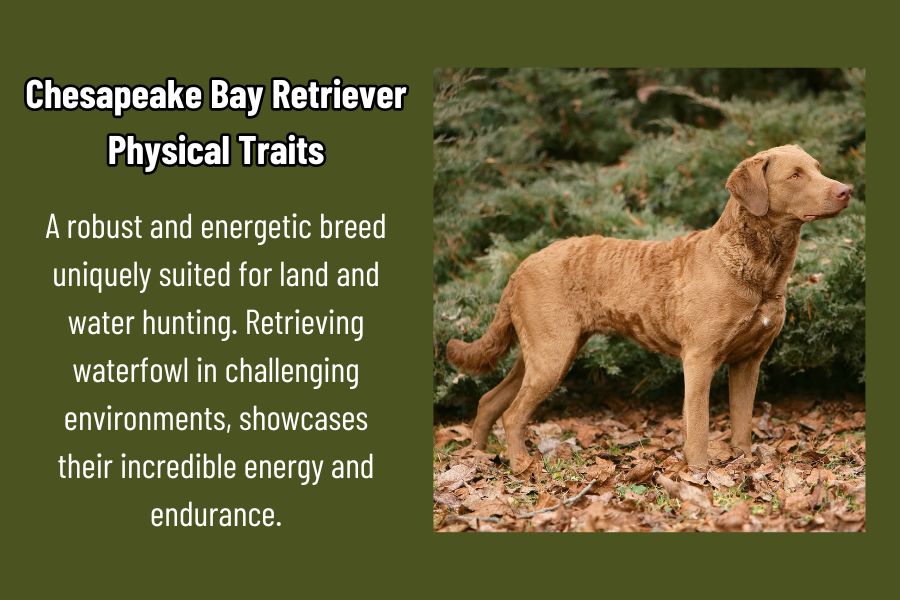
The Chesapeake Bay Retriever is a robust and versatile breed, well-suited to a variety of demanding environments. These physical traits reflect their heritage and purpose, making them exceptional dogs:
Excellent Water Dogs
Chesapeake Bay Retrievers excel in aquatic environments, adapting well to various weather and water conditions. They are known for their ability to handle strong tides, icy conditions, and cold water. Their webbed feet and muscular build make them powerful swimmers, while their oily double coat provides insulation and repels water, allowing them to navigate harsh weather with ease. These traits make them uniquely suited for retrieving waterfowl in challenging environments.
Size (Length and Height)
Chesapeake Bay Retrievers are medium to large dogs, with males typically standing between 23 to 26 inches at the shoulder and females between 21 to 24 inches. Their length is proportionate to their height, giving them a balanced and sturdy appearance. This size enables them to perform vigorous activities, such as swimming and retrieving, with efficiency and strength.
Head and Muzzle (Soft Mouth)
The breed features a broad, round head with a medium-length muzzle that tapers slightly. Chesapeake Bay Retrievers are known for their “soft mouth,” a crucial trait for retrieving game without damaging it. Their strong jaws and gentle grip allow them to carry birds delicately, ensuring the game is returned to the hunter in excellent condition.
Body Structure and Weight
Chesapeake Bay Retrievers have a muscular and athletic body structure. Males typically weigh between 65 to 80 pounds, while females weigh between 55 to 70 pounds. Their robust frame and strong limbs provide the power needed for endurance activities, such as swimming against strong currents and traversing rough terrain.
Coat Type and Colors
The breed’s coat is one of its most distinctive features. Chesapeake Bay Retrievers have a dense, oily double coat that is water-resistant, helping them stay dry and warm in cold water. The outer coat is short and curly or wavy, while the undercoat is soft and thick. Coat colors range from shades of brown, sedge (red-gold), to the dead grass Chesapeake Bay Retriever. This coloration provides natural camouflage in their typical hunting environments.
Keen Senses
Chesapeake Bay Retrievers possess sharp senses, particularly their sense of smell and vision, which are vital for locating and retrieving game. Their acute hearing also aids in detecting and responding to commands, making them highly effective working dogs.
Tail Structure and Purpose
The breed’s tail is medium-length, thick at the base, and tapering to the tip. Covered in dense fur, it acts as a rudder during swimming, helping the dog maintain balance and direction in the water. This functional tail is crucial for their efficiency as water retrievers.
Energy and Endurance
Chesapeake Bay Retrievers are known for their high energy levels and remarkable endurance. They require regular, vigorous exercise to maintain their physical and mental well-being. Their stamina allows them to perform demanding tasks for extended periods, whether in the water or on land.
Life Expectancy
The average life expectancy of a Chesapeake Bay Retriever is between 10 to 13 years. With proper care, including a balanced diet, regular exercise, and routine veterinary check-ups, these dogs can lead healthy and active lives well into their senior years.
Gestation Period and Litter Size
The gestation period for a Chesapeake Bay Retriever is approximately 63 days. Litters typically consist of 7 to 9 puppies, although this can vary. Breeders should ensure that the mother receives adequate nutrition and care throughout the gestation period to support the health of both the mother and the puppies.
Chesapeake Bay Retriever Behavioral Traits
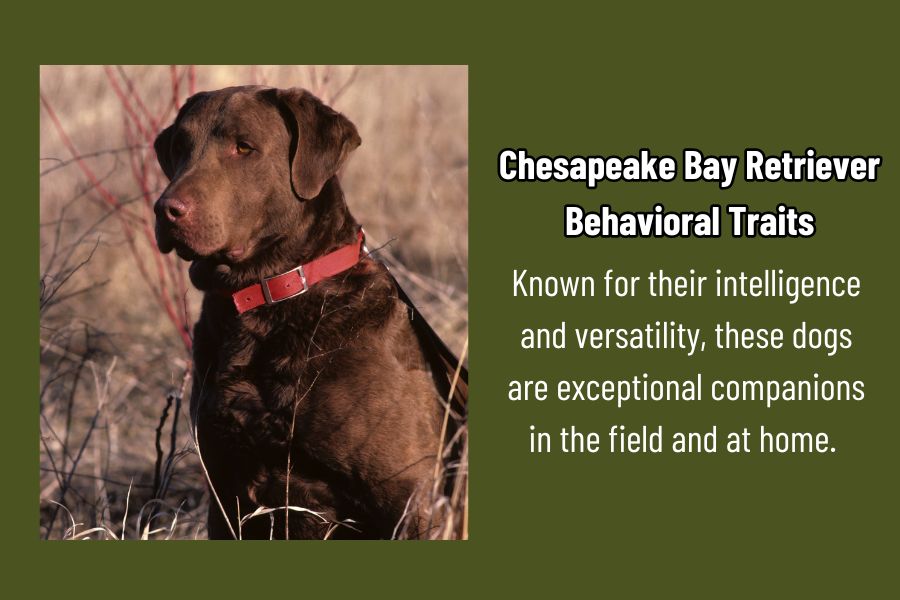
The Chesapeake Bay Retriever is not only known for its physical prowess but also for its distinct behavioral traits. These dogs are intelligent, versatile, and loyal, making them exceptional companions for various activities and family life.
Prey Drive
Chesapeake Bay Retrievers possess a strong prey drive, a trait deeply embedded in their hunting heritage. This drive makes them highly effective retrievers, capable of tracking and retrieving game with precision. Their instinctual urge to chase and capture prey is balanced by their training, allowing them to perform their tasks efficiently without causing harm to the game.
Intelligence
Intelligence is a hallmark of the Chesapeake Bay Retriever. These dogs are quick learners, able to grasp new commands and tasks with ease. Their sharp minds make them adept at problem-solving, which is essential for hunting and other complex activities. This intelligence also means they require mental stimulation to prevent boredom and maintain their overall well-being.
Versatility
The Chesapeake Bay Retriever’s versatility is one of its most admired traits. Originally bred for retrieving waterfowl, these dogs excel in various roles beyond hunting. They are proficient in search and rescue, therapy work, and competitive sports such as agility and obedience. They also are natural guard dogs protecting their handler and family. Their adaptability makes them suitable for diverse environments and activities, showcasing their remarkable flexibility and capability.
Temperament
Chesapeake Bay Retrievers are known for their balanced temperament. They are typically calm, confident, and assertive, yet not aggressive. These dogs are composed in different situations, making them reliable companions both in the field and at home. Their steady demeanor allows them to interact well with humans and other animals, contributing to their overall amiable nature.
Trainability
Trainability is another key trait of the Chesapeake Bay Retriever. Their intelligence and eagerness to please make them very responsive to training. Positive reinforcement techniques work best with this breed, as they respond well to praise and rewards. Consistent training from an early age helps channel their energy and prey drive into productive activities, ensuring they grow into well-behaved adults.
Loyalty and Protective
Loyalty is deeply ingrained in the Chesapeake Bay Retriever. These dogs form strong bonds with their families and are known for their unwavering devotion. Their protective nature makes them excellent watchdogs, as they are always alert and ready to defend their loved ones. This loyalty and protectiveness do not translate to unnecessary aggression but rather a vigilant and caring attitude towards their family.
Family Compatibility
Chesapeake Bay Retrievers are highly compatible with family life. They are affectionate and gentle with children, often forming close bonds with younger family members. Their playful nature makes them great companions for kids, while their protective instincts ensure they watch over the family. However, they do best in active households where they receive plenty of physical exercise and mental stimulation.
How to Choose the Right Chesapeake Bay Retriever Puppy?
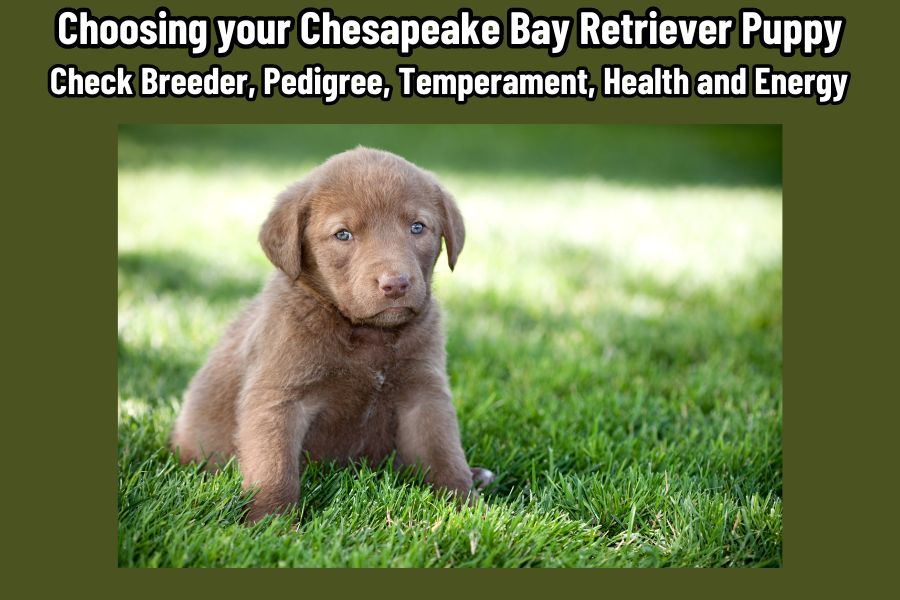
Choosing the right Chesapeake Bay Retriever puppy is a crucial step that requires careful consideration and research. Selecting a healthy, well-tempered puppy from a reputable source will set the foundation for a long, happy relationship with your new companion.
Breeder and Pedigree
When looking for a Chesapeake Bay Retriever puppy, start by finding a reputable breeder. A responsible breeder will provide detailed information about the puppy’s lineage and pedigree, ensuring that the breeding practices prioritize health, temperament, and breed standards.
Look for breeders who are members of recognized kennel clubs, such as the American Kennel Club (AKC) or the United Kennel Club (UKC). These breeders typically follow stringent guidelines to maintain the breed’s integrity. Visiting the breeder’s facility can give you insight into the conditions in which the puppies are raised and allow you to meet the puppy’s parents, providing a glimpse into the potential temperament and physical traits of your future dog.
Temperament
Temperament is a key factor when selecting a Chesapeake Bay Retriever puppy. Spend time with the puppies and observe their behavior. A well-tempered puppy should be curious, playful, and friendly without showing signs of excessive shyness or aggression. Interact with the puppies to see how they respond to human contact. Additionally, ask the breeder about the temperament of the puppy’s parents, as this can often be an indicator of the puppies’ future behavior.
Health and Energy Level
Health is paramount when choosing any puppy. Ensure that the breeder provides health clearances for both the puppy and its parents. These clearances should include tests for common genetic disorders in Chesapeake Bay Retrievers, such as hip dysplasia, elbow dysplasia, and progressive retinal atrophy.
A healthy puppy will be active, have a shiny coat, clear eyes, and a good appetite. Energy level is also an important consideration. Chesapeake Bay Retrievers are known for their high energy and endurance, making them ideal for active families who enjoy outdoor activities. Assess the puppy’s energy level to ensure it matches your lifestyle and activity level.
Caring for your Chesapeake Bay Retriever
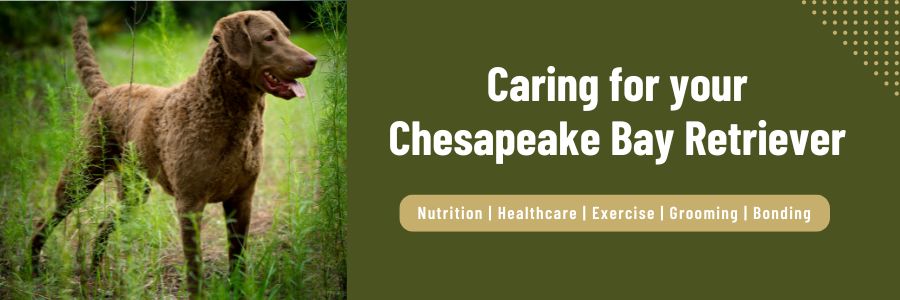
Proper care for your Chesapeake Bay Retriever ensures they live a healthy, happy, and fulfilling life. Here are some important tips:
Nutrition and Healthcare Tips
A balanced diet is essential for maintaining the health and vitality of your Chesapeake Bay Retriever. Provide high-quality dog food that meets their nutritional needs based on their age, size, and activity level. Puppies require food rich in protein and fat to support growth, while adult dogs benefit from a diet that maintains muscle mass and energy. Always ensure fresh water is available.
Regular veterinary check-ups are crucial for early detection and prevention of health issues. Chesapeake Bay Retrievers are prone to ear infections, certain genetic conditions, such as hip dysplasia and progressive retinal atrophy. Routine vaccinations, parasite prevention, and dental care are also important aspects of healthcare. Consult your vet about the best practices for your dog’s specific needs and schedule regular health screenings.
Exercise and Grooming Tips
Chesapeake Bay Retrievers are high-energy dogs that require ample exercise to stay fit and happy. Daily activities should include a mix of physical exercises, such as long walks, runs, and playtime, as well as mental stimulation through interactive games and training. Water activities like swimming are particularly beneficial, given their natural affinity for water.
Grooming is another vital aspect of caring for your Chesapeake Bay Retriever. Their dense, oily double coat requires regular brushing to prevent matting and to remove loose hair. Bathing should be done as needed, but not too frequently, to avoid stripping the coat of its natural oils. Regular nail trimming, ear cleaning, and dental hygiene are also important to keep your dog in top condition.
Bonding Tips
Building a strong bond with your Chesapeake Bay Retriever enhances their overall well-being and your relationship with them. Spend quality time together through play, training, and relaxation. Incorporate activities that both you and your dog enjoy, such as hiking, fetching games, agility courses and swimming. Use treats, praise, and affection to reward good behavior. Positive reinforcement training not only helps in managing behavior but also strengthens the bond, reinforces your role as a leader and builds mutual respect and trust..
Chesapeake Bay Retriever Training Tips
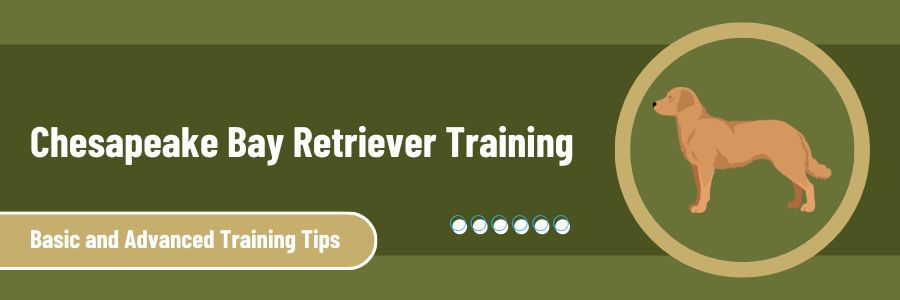
Chesapeake Bay Retriever training should be a rewarding experience. It’s crucial for building a great dependable partner in the field and a happy companion at home. Here are some key tips for training your Chesapeake Bay Retriever from puppyhood through adulthood:
Basic Puppy Training Tips
Starting training early is key to establishing good habits and a strong bond with your Chesapeake Bay Retriever. Here are some fundamental training tips for your puppy:
- Socialization: Expose your Chesapeake Bay Retriever puppy to a variety of people, environments, and other animals. This helps them become well-adjusted and confident. Positive interactions during this critical period are essential for preventing fear and aggression issues later in life.
- House Training: Consistency is crucial when house training your puppy. Take them outside frequently, especially after eating, playing, and waking up. Use a designated spot for them to relieve themselves and reward them with praise and treats when they do it correctly. Patience and consistency are key.
- Basic Commands: Teach your Chesapeake Bay Retriever basic commands such as “sit,” “stay,” “come,” and “leave it.” Use positive reinforcement techniques, including treats, praise, and play, to encourage desired behaviors. Short, frequent training sessions are more effective than long, sporadic ones.
- Crate Training: Crate training provides your puppy with a safe and secure space and aids in house training. Make the crate a positive place by associating it with treats, toys, and comfort. Gradually increase the time your puppy spends in the crate to help them feel comfortable and secure.
- Leash Training: Introduce your Chesapeake Bay Retriever puppy to a leash early on. Start with short walks and gradually increase the distance. Use treats and praise to reward them for walking calmly by your side. This sets the foundation for good leash manners and enjoyable walks.
Advanced Training Tips
As your Chesapeake Bay Retriever matures, around one year of age, you can begin to introduce more advanced training. These tips will help keep their minds and bodies active and engaged:
- Advanced Obedience: Build on the basic commands by introducing more complex tasks such as “heel,” “place,” and “off-leash recall.” Use high-value rewards and vary your training locations to challenge your dog and reinforce their skills in different environments.
- Agility Training: Chesapeake Bay Retrievers are athletic and enjoy physical challenges. Agility training involves navigating obstacle courses, which enhances their physical fitness and mental sharpness. Start with simple obstacles and gradually increase the complexity as your dog gains confidence and skill.
- Retrieving and Scent Work: Given their hunting background, Chesapeake Bay Retrievers excel at retrieving and scent work. Use these skills to engage them in advanced games and tasks. Teach them to retrieve specific objects or find hidden items based on scent. This keeps them mentally stimulated and physically active.
- Consistent Reinforcement: Advanced training requires consistent reinforcement of commands and behaviors. Regular practice sessions, combined with positive reinforcement, will help solidify your dog’s advanced skills. Be patient and persistent, and always reward progress and effort.
- Professional Trainer: When it comes to training your Chessie Retriever my best tip is…consider hiring a professional trainer. Their experience ensures a customized approach for addressing control problems such as aggression and stubbornness. They also have specific and proven techniques for training your dog the proper way to retrieve.
Conclusion
Throughout this guide, we’ve explored the rich history and origins of the Chesapeake Bay Retriever, delving into their development and modern status. We discussed their physical traits, including their adaptability to various weather conditions, impressive size, and distinctive coat. We also highlighted their behavioral traits, such as their intelligence, trainability, and loyalty. Additionally, we provided essential tips on selecting the right puppy, caring for your dog, and implementing effective training strategies.
With proper care, training, and a loving environment, the Chesapeake Bay Retriever will not only meet but exceed your expectations as loyal companions and skilled working dogs.
FAQs: Chesapeake Bay Retriever
What are Chesapeake Bay Retrievers best at?
Chesapeake Bay Retrievers are best known for their exceptional abilities as retriever dogs, particularly in retrieving waterfowl. Their powerful build, webbed feet, and water-resistant coat make them ideally suited for working in harsh and icy water conditions. They excel in roles that require endurance, strength, and intelligence, such as search and rescue missions and competitive dog sports like agility and obedience trials.
What breeds make up a Chesapeake Bay Retriever?
The Chesapeake Bay Retriever’s ancestry includes a mix of breeds that were prized for their hunting and retrieving skills. Their lineage traces back to two Newfoundland dogs rescued from a shipwreck off the coast of Maryland in 1807. These dogs were bred with local retrievers, hounds, and possibly water spaniels to create a breed that combined the best traits of its ancestors: resilience, a strong work ethic, and an excellent sense of smell.
How much do Chesapeake Bay Retrievers cost?
The Chesapeake Retriever price can vary significantly based on factors such as breeder reputation, pedigree, and location. On average, you can expect to pay between $800 to $2,500 for a puppy. It’s important to invest in a reputable breeder who prioritizes health and temperament to ensure you bring home a well-bred and healthy puppy.
Do Chesapeake Bay Retrievers shed a lot?
Yes, Chesapeake Bay Retrievers do shed, particularly during the spring and fall when they blow their coats. They have a dense double coat designed to protect them in harsh weather conditions, which requires regular grooming to manage shedding. Weekly brushing can help reduce shedding and keep their coat healthy by removing loose hair and distributing natural oils.
What are the potential health problems with Chesapeake Bay Retrievers?
Chesapeake Bay Retrievers are generally robust and healthy dogs, but like all breeds, they can be prone to certain health issues. One concern is exercise-induced collapse (EIC), a genetic disorder that causes muscle weakness, incoordination, and collapse after intense exercise. Hip dysplasia is another common issue, where the hip joint doesn’t fit together perfectly, leading to arthritis or lameness. Progressive retinal atrophy (PRA) is a degenerative eye disorder that can cause blindness over time.
Additionally, Type 3 von Willebrand disease, a blood clotting disorder, can be present in the breed, leading to excessive bleeding. Cataracts are also a concern, potentially affecting vision as the dog ages. Regional alopecia, a condition that causes hair loss in certain areas, can affect both male and female Chesapeakes. Regular veterinary check-ups and responsible breeding practices can help mitigate these risks, ensuring a healthier life for your Chesapeake Bay Retriever.
What are the key differences between a Chesapeake Bay Retriever and a Labrador Retriever?
While both breeds are excellent retrievers and beloved family pets, there are several key differences between Chesapeake Bay Retrievers and Labrador Retrievers. Chesapeakes are generally more reserved and protective, making them excellent watchdogs, whereas Labradors are known for their outgoing and friendly nature.
Chesapeake Bay Retrievers have a distinctive wavy, oily coat that provides extra insulation in cold water, whereas Labradors have a straight, dense coat. Additionally, Chesapeakes are known for their stubborn streak and independent thinking, which can make training more challenging compared to the more eager-to-please Labrador.
Resources: Chesapeake Bay Retriever
SPECIAL NOTE: “The information provided in this post is based on Google research and the Resource links listed below. While we try to keep the information for this post current, there are no representations expressed or implied, about the completeness, or accuracy of the information provided. Therefore all hunters should always verify current information from these resources along with other local and federal publications”.
Online Resources
- AKC – American Kennel Club
- TKC – The Kennel Club
- UKC – United Kennel Club
- CKC – Canadian Kennel Club
- ACC – American Chesapeake Club
- CBRRR – Chesapeake Bay Retriever Relief and Rescue
Best Books
- “The Chesapeake Bay Retriever: Decoys, Guns, and Dogs” by C. John Sullivan Jr.
- Description: This book explores the rich history and development of the Chesapeake Bay Retriever breed, along with its role in hunting and retrieving.
- “The Chesapeake Bay Retriever: An Owner’s Guide to a Happy Healthy Pet” by Dan Rice
- Description: A practical guide that covers all aspects of owning and caring for a Chesapeake Bay Retriever, including training, nutrition, and health care.
- “Chesapeake Bay Retrievers” by Joe Stahlkuppe
- Description: This book provides an in-depth look at the breed’s characteristics, training tips, and care requirements. It’s a great resource for both new and experienced owners.
- “Chesapeake Bay Retrievers: Everything about History, Care, Nutrition, Handling, and Behavior” by Nona Kilgore Bauer
- Description: A comprehensive resource that covers the history, care, and training of Chesapeake Bay Retrievers. It includes expert advice and practical tips for maintaining a healthy, happy dog.
- “The New Complete Chesapeake Bay Retriever” by Janet Horn
- Description: An updated guide that delves into the breed’s history, standards, and breeding practices. It’s an excellent reference for anyone interested in the Chesapeake Bay Retriever’s lineage and care.


